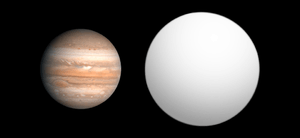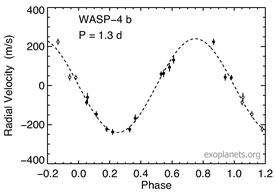WASP-4b
| Exoplanet | List of exoplanets | |
|---|---|---|
 | ||
| Parent star | ||
| Star | WASP-4 | |
| Constellation | Phoenix | |
| Right ascension | (α) | 23h 34m 15.0858s[1] |
| Declination | (δ) | −42° 03′ 41.0495″[1] |
| Apparent magnitude | (mV) | 12.468±0.025[2] |
| Distance | 880±10[1] ly (269±4[1] pc) | |
| Spectral type | G7V[3] | |
| Orbital elements | ||
| Semi-major axis | (a) | 0.02255+0.00095 −0.00065[4] AU |
| Eccentricity | (e) | 0.0[4] |
| Orbital period | (P) | 1.3382324+0.0000017 −0.0000029[4] d |
| Inclination | (i) | 89.35+0.64 −0.49[4]° |
| Time of transit | (Tt) | 2454383.313070+0.000045 −0.000074 HJD[4] |
| Semi-amplitude | (K) | 247.6+13.9 −6.8[4] m/s |
| Physical characteristics | ||
| Mass | (m) | 1.21+0.13 −0.08[4] MJ |
| Radius | (r) | 1.304+0.054 −0.042[4] RJ |
| Temperature | (T) | 1650 ± 30[4] |
| Discovery information | ||
| Discovery date | October 31, 2007[5] | |
| Discoverer(s) | David. M. Wilson et al. (SuperWASP)[3] | |
| Discovery method | Transit | |
| Discovery site | SAAO | |
| Discovery status | Published[3] | |
| Database references | ||
| Extrasolar Planets Encyclopaedia | data | |
| SIMBAD | data | |
| Exoplanet Archive | data | |
| Open Exoplanet Catalogue | data | |
WASP-4b is an extrasolar planet approximately 880 light-years away in the constellation of Phoenix.[1][3] The planet was discovered orbiting the star WASP-4 in October 2007. The planet's mass and radius indicate that it is a gas giant, similar to Jupiter.[6] WASP-4b is close enough to its star to be classified as a hot Jupiter and has an atmospheric temperature of approximately 1650 K.[3][4]

The planet was the discovered by the SuperWASP project using cameras in South Africa.[6] After its discovery, the mass of the WASP-4 b was determined by measuring the radial velocity of WASP-4, which confirmed that the object that caused the transit was a planet.[3]
References
- 1 2 3 4 5 Brown, A. G. A.; et al. (Gaia collaboration) (August 2018). "Gaia Data Release 2: Summary of the contents and survey properties". Astronomy & Astrophysics. 616. A1. arXiv:1804.09365. Bibcode:2018A&A...616A...1G. doi:10.1051/0004-6361/201833051. Gaia DR2 record for this source at VizieR.
- ↑ Henden, A. A.; et al. (2016). "VizieR Online Data Catalog: AAVSO Photometric All Sky Survey (APASS) DR9 (Henden+, 2016)". VizieR On-line Data Catalog: II/336. Originally published in: 2015AAS...22533616H. 2336. Bibcode:2016yCat.2336....0H. Vizier catalog entry
- 1 2 3 4 5 6 Wilson, D. M.; et al. (2008). "WASP-4b: A 12th Magnitude Transiting Hot Jupiter in the Southern Hemisphere". The Astrophysical Journal Letters. 675 (2): L113–L116. arXiv:0801.1509. Bibcode:2008ApJ...675L.113W. doi:10.1086/586735.
- 1 2 3 4 5 6 7 8 9 10 Table 3, Improved parameters for the transiting hot Jupiters WASP-4b and WASP-5b, M. Gillon et al., Astronomy and Astrophysics 496, #1 (2009), pp. 259–267, doi:10.1051/0004-6361:200810929, Bibcode: 2009A&A...496..259G.
- ↑ "Astronomer discovers new planets". BBC News. 2007-10-31. Retrieved 2018-09-23.
- 1 2 Sherriff, Lucy (2007-10-31). "UK boffins ID three new exo-planets". The Register. Retrieved 2018-09-23.
External links
![]()
- "SuperWASP Homepage". Archived from the original on 2002-12-08. Retrieved 2008-07-02.
- "UK planet hunters announce three new finds" (PDF). 2007-10-30. Archived from the original (PDF) on 2008-05-16. Retrieved 2008-07-02.
Coordinates: ![]()